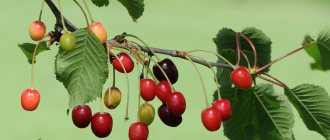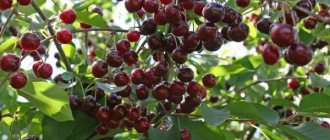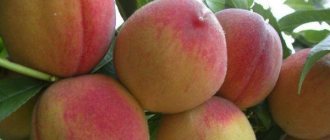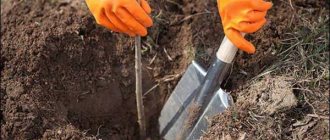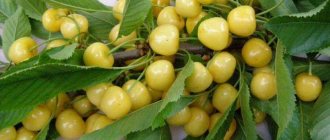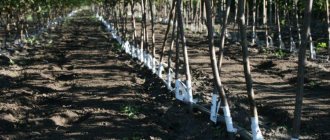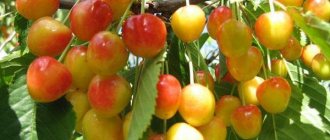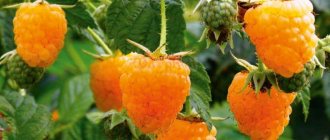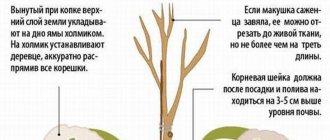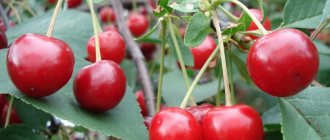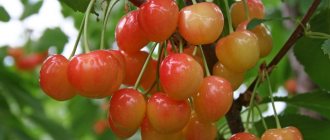Yellow cherries are especially popular among gourmets: they are large, sweet and juicy. What varieties are best to choose for planting in your garden? We list the most popular of them and attach their description along with a photo.
The main advantage of yellow cherry varieties over classic red fruits is their excellent taste and high crop yield. To make it easier for you to choose the best variety, in this article we will provide a detailed description of the most popular varieties of yellow cherries appreciated by gardeners.
Bryansk yellow
Medium ripening variety. Trees of this variety are resistant to rot and diseases such as coccomycosis, clasterosporiosis and moniliosis, and are characterized by high winter hardiness and moderate growth. Thanks to this, even in the harshest winters, no more than 10% of the flower buds on these cherries freeze.
The berries of Bryansk yellow cherries are round and dense, they are juicy and resistant to cracking. The detachment from the stalk is dry.
| Entry into fruiting | Tree height (m) | Fruit weight (g) | Harvest | Pollinator varieties |
| For the 5th year | 4-5 | 4-6 | End of June – beginning of July | And the way, Revna, Tyutchevka, Ovstuzhenka |
Further care
During the active growth of the tree (most often this is June), the plant is watered abundantly; the water should penetrate to a depth of about 40 cm, where the roots are located. Watering is also required if dry weather arrives. Because Due to excess moisture, the berries may burst; during their ripening, the tree is not watered. High humidity can reduce the growth rate of shoots; to avoid this, watering is also stopped at the end of July and beginning of August.
Recommendation! Mature trees older than 4 years are best fed in early May with superphosphate, urea and potassium. All elements are mixed together at 20 g/m2 each.
After harvesting, it is best to feed with organic matter and minerals.
Cherries must be pruned:
- To prevent self-pollinating cherries from stretching too long, the trunk is cut from the first thick branch at a height of about 60 cm; this is done in the first year.
- In the second spring, 3-4 lower branches are selected, which are directed in different directions, and cut off, leaving 50 cm to the trunk.
- In the third year of life, all branches that grow towards the central trunk are removed.
- At the age of 4 years, the tree shape is formed and divided into tiers. The branches of each tier are made 20 cm longer.
After 5 years, all work should be completed, because... Fruiting begins.
Leningrad yellow
The trees have a spherical crown, have excellent winter hardiness and productivity, as well as resistance to fruit rot and fruit flies.
The berries of the Leningradskaya yellow cherry variety are juicy, slightly tart, with a slight “bitterness”. They are distinguished by an amber hue.
| Entry into fruiting | Tree height (m) | Fruit weight (g) | Harvest | Pollinator varieties |
| For the 4th-5th year | Up to 4 | Not less than 3.5 | End of August | Zorka, Leningradskaya black, Leningradskaya pink |
Preparing cherries for winter
Considering the natural frost resistance of the Homestead Yellow, it remains to create the most comfortable conditions for it, protecting it from other troubles:
- It is good to dig up the soil around the trunk.
- To prevent damage to the trunk by rodents, tie it with burlap, rags, spruce branches, and wrap it with roofing felt.
- In September, water the tree with a superphosphate solution or treat the foliage to strengthen the cherries and help them during frosts.
- To prevent sunburn, whitewash trees with lime and clay, and young trees with clay and chalk, since lime can damage their bark.
Rossoshanskaya gold
Tall trees of this variety are distinguished by a pyramidal crown with medium density.
The berries of Rossoshanskaya golden cherries have dense pulp, they are large and seem to be slightly squeezed on the sides. In bright sunlight, the berries may take on a pink tint. They taste juicy and sweet, with a slight sourness. The seed is slightly elongated, smooth, and can be separated from the berry without much effort. The fruits are dense and do not crack.
Since the variety is not self-pollinating, it is advisable to plant nearby trees of pollinating varieties that bloom at the same time.
- Top 7 best self-fertile cherry varieties
If the area of the plot does not allow you to plant several cherry trees, choose a seedling of a self-fertile variety!
The undoubted advantage of the variety is that it is adapted to the conditions of the middle zone, since it was bred on the territory of the Russian Federation.
| Entry into fruiting | Tree height (m) | Fruit weight (g) | Harvest | Pollinator varieties |
| For the 4th-5th year | From 3 | 6-7 | End of June – beginning of July | Miracle cherry, Night, Ovstuzhenka |
- Top 10 varieties of cherries for every taste
Description and photos of the best varieties of cherries.
Planting cherries on the site
Recommended timing and planting scheme
When is the best time to plant? Gardeners have different opinions: some insist on autumn, others prefer spring. In both cases, there may be risks for the fragile plant. This is either an unexpectedly frosty, snowless winter, or the time from frost to bud break is too short to have time to purchase a seedling and plant it. And the yellow cherry blossoms early.
Therefore, experienced specialists select seedlings in the fall and plant them in the spring. To preserve the tree over the winter, it is buried in a semi-horizontal position on a high, level area with loose soil. In winter, you need to cover it well with snow, and if there is none yet, but the frost is getting stronger, cover it with straw, rags or peat, or an old blanket.
In winter, there will be time to think about where the most suitable place for planting is, so as not to replant later. Cherry doesn't like this.
By the way: you can’t replant trees with blossoming leaves..
In the spring (as soon as the soil allows), bare-rooted seedlings are planted. Those purchased in a container can be planted at any time, from April to October.
Homestead yellow cherries are usually planted according to a 3 m x 3 m pattern. It is believed that it is a good idea to place it almost close to the house or other dacha building. So that the northern winds do not bother you. Then it will be easier for her to survive the winter.
Summer resident
The trees of this variety are medium-sized, with a spreading crown of medium density. They are drought and frost resistant.
The berries are round-heart-shaped, very juicy, tender, with sweet pulp and a well-separable seed. However, the variety is self-sterile, and therefore needs “neighborhood” with trees of pollinating varieties.
| Entry into fruiting | Tree height (m) | Fruit weight (g) | Harvest | Pollinator varieties |
| For the 4th year | 3,5 | 7-11 | Mid June | Drogana yellow, Melitopol, Talisman |
Drogana yellow
The trees of this variety, popular all over the world, adapt well to different weather conditions, so today this cherry can be found in summer cottages in Europe and Asia.
The tree grows very tall and leafy, so it takes up quite a lot of space in the garden. But thanks to this, the variety is characterized by high productivity. Flowering occurs relatively late, so cherries are not afraid of return spring frosts, which often occur in the middle zone.
The variety is self-sterile, so it is necessary to plant trees of pollinating varieties nearby.
The Drogana yellow variety is distinguished by rather large, round-shaped berries with very smooth skin and dense, sweet and juicy light yellow pulp. The juice is clear. 100 g of pulp contains 6.6 mg of vitamin C.
In addition to an excellent harvest (up to 150 kg per tree), this cherry is valued for its good drought and frost resistance. Plus, she rarely gets infected with fungal diseases. Disadvantages include poor separation of the seeds from the pulp, as well as poor transportability of the berries due to the very thin skin. Also, the berries are completely unsuitable for freezing: after defrosting, they lose their shape - the peel bursts and the pulp spreads.
| Entry into fruiting | Tree height (m) | Fruit weight (g) | Harvest | Pollinator varieties |
| For 3-5 years | 5-6 | 6,5-8 | End of June – beginning of July | Donchanka, Sister, Aelita |
Preparation of the planting pit and planting technology
The location is selected carefully: safe from northern winds, with a distance from the surface to groundwater of at least 1.5-2 m. When water occurs closer, drainage is necessary to ensure the required level of moisture.
If cherries are planted in the fall, the pit is prepared in a month or two. If it’s spring, the hole is dug in October. A soil of suitable composition is formed: coarse sand is added to the clayey soil, and peat and clay are added to the sandy soil. The natural acidity level for yellow cherries is pH 6.5-7.
See also
How to properly grow cherries from pits at home and rules for caring for seedlingsRead
Usually, Homestead yellow is planted using a technology common to cherries:
- dig a hole with a diameter of 90 cm and a depth of up to 60 cm;
- pour a mixture of humus and a small amount of garden soil into it;
- add 1 kg of stove ash and about 0.5 kg of superphosphate there, mix everything, form a mound;
- drive a support peg into the mound;
- before planting, the roots are soaked for 10 hours;
- then dip them in a 5-liter solution of mullein with half the amount of clay;
- maintaining the position of the root collar 5-6 cm above the surface, the seedling is lowered into a hole next to the peg, the roots are straightened over the mound and covered with garden soil;
- trample down the soil around the tree;
- tie him to a support;
- Water the planting site generously and mulch with humus.
Mlievskaya yellow
The height of trees of this variety exceeds the average; they have a wide pyramidal crown of medium density. Over time, the crown may become rounded and slightly asymmetrical.
The berries of Mlievskaya yellow are quite large, with a glossy-golden skin, juicy, semi-cartilaginous, sweet and sour yellow pulp, from which the seed is easily separated. The juice is clear.
The variety has one significant drawback: in snowless and harsh winters, the trees can freeze. Therefore, in the middle zone they need shelter. But in the southern regions they give a good harvest without any hassle.
| Entry into fruiting | Tree height (m) | Fruit weight (g) | Harvest | Pollinator varieties |
| After 4-5 years | 4 | 4,9-6 | Second half of June | The variety is self-fertile - does not require pollinators |
Benefit
The berries contain a large amount of useful substances. That's why they:
- reduce blood clotting, prevent the formation of blood clots (due to the presence of coumarin and oxycoumarin);
- promote the active removal of toxins from the body;
- lower cholesterol levels;
- activate the liver and gallbladder;
- help in the treatment of psoriasis and skin diseases;
- reduce blood pressure;
- help increase the amount of iron in the blood;
- rejuvenate epithelial cells, smooth out wrinkles, tone and nourish the skin;
- strengthen the immune, nervous, cardiovascular systems;
- treats sexual dysfunction in men.
Not only cherry fruits are useful, but also the leaves. They are recommended to be brewed for rheumatic pain, to prevent the risk of infection, and to treat colds. Eating berries is beneficial for pregnant women. They prevent anemia in the unborn child and strengthen his muscles and bones. It is recommended to use the gardening product for people suffering from thyroid diseases and diabetes.
Important! Cherries should not be eaten by women carrying a child if they have individual intolerance to fiber and have difficulty digesting heavy carbohydrates.
Homestead yellow
This variety is especially popular in the Central region of Russia, but grows well in other areas. At the same time, the tree grows quickly. It is noteworthy that this variety is early. But usually in central Russia during flowering the buds do not freeze during spring frosts.
The fruits of this variety are round, with a wide funnel. They have smooth skin and very juicy yellow flesh with a sweet and sour taste. 100 g of berries contain 10.6 mg of vitamin C.
The disadvantage of the Homestead yellow cherry fruit is that the seed in them is quite large (8.5% relative to the weight of the berry). But it separates well from the pulp.
Also, one of the disadvantages of this variety is that it is troublesome to grow: trees need regular pruning and take up a lot of space in the garden, so it will not be possible to plant many of these plants.
| Entry into fruiting | Tree height (m) | Fruit weight (g) | Harvest | Pollinator varieties |
| 6 years after landing | 3,5-4 | 5,5 | First half of June | The variety is self-fertile and does not require pollinators. |
Transportability and use of berries
For some, the impressive annual yield turns into a disadvantage of the variety: large, juicy cherries do not tolerate travel and are therefore not transportable. It would not be possible to grow Homestead Yellow in commercial quantities. That's why it's named like that.
This is a table variety. Berries are consumed mainly fresh. They retain pristine freshness for a long time in the refrigerator. Many are prepared in the form of juices, jams, preserves and compotes, remarkable in that the berries remain dense and do not boil over. Sometimes, in order to have time to fully use the harvest, cherries are frozen.
Not only are cherry fruits a source of many essential microelements, they also support blood vessels and counteract anemia. Like all yellow fruits, Homestead yellow does not provoke allergic reactions.
See also
Description of the cherry variety Iput and pollinators, choice of planting site, cultivation and careRead
